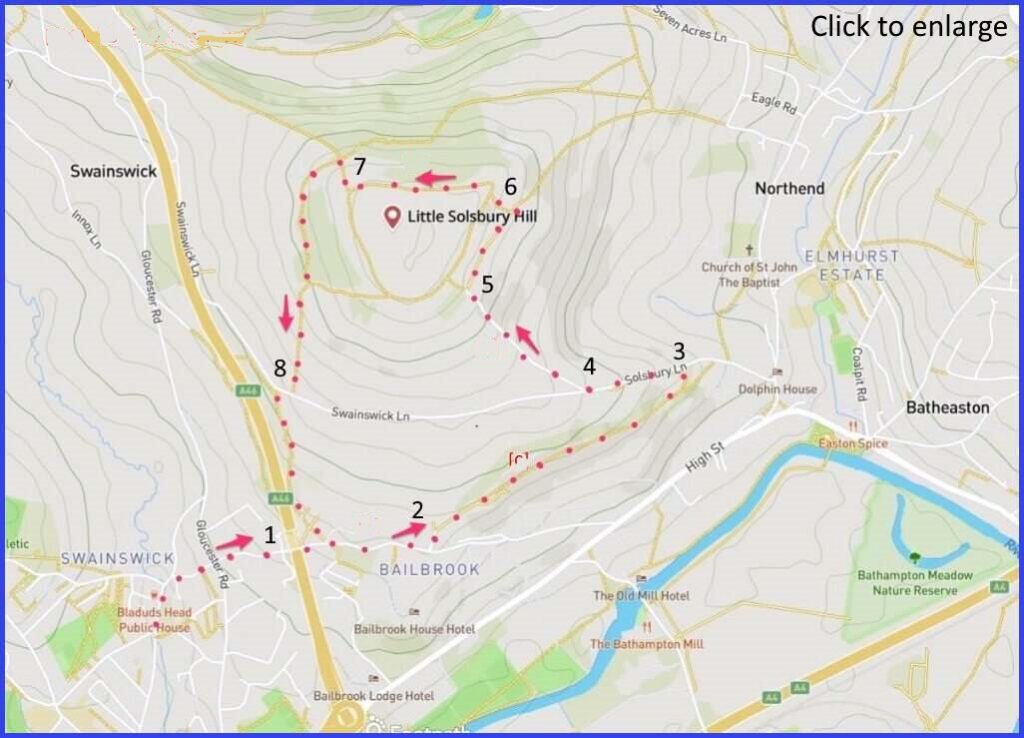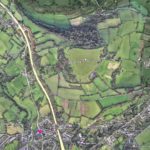(Routes from map points + metres to next point)
Start (and park?) in Larkhall village. The postcode lands you at one of the pubs. Walk up Deadmill lane and quickly veer into Ferndale Road. Stay on Bailbrook Lane towards bridge over bypass, 220m
1: Cross above the bypass. Follow to second junction on left that leads to farm buildings. 350m
2: Take this path (beyond the turn with barred gate next to it) and shortly veer right and pick up a footpath that eventually traverses a wooded area into an open field with an exit diagonally across onto Swainswick lane. 850m
3: Turn left onto the lane and walk forwards to Solsbury lane.
4 Veer right onto this lane and continue following it. 400m
5 At lane gives way to paths from which you could mount the Hill. One is shownn on this map along the path. 210m
6: The rise indicated is a slightly less steep thann some. Take it and walk anit-clockwise around the plateau. 470m
7: This is just one point at which you can drop down and follow a path back to Swainswick lane. 700m
8: Turn right on the lane and quickly pick up a bath that leads back to Bailbrook Lane and your starting point.700m
The pictures below are in the order things were seen on this walk. Clicking on any one will enlarge it (and the slideshow)
The walk
Not many challenging stiles and gates but the walk is steep. It begins on a light traffic road, then passing along a residential lane. Field paths follow until Solsbury Lane takes the walker onto the plateau that is Solsbury Lane. This can be circles around and there are various points (in addition to the one mapped here) that will get you back down into the village
Tin church
The roadway at the start is quite steep (but not busy). It takes you over the A46 bypass road and along a pleasant lane with many Georgian cottages. There is an old school (pic A) but (special treat) then there appears the Bailbrook Mission Tin Church. These tin churches are quite rare. This one was built in 1892 from a mail-order kit (timber frame and corrugated iron) all for the spiritual benefit of those who worked in the nearby orchard for the Robertson’s jam company. This particular example was one of the most expensive models (and ecclesiastically correct), taken from a catalogue of 1889. In the 1970s it was purchased by a local theatre veteran for £1500. With the help of a local architect he worked to rescue the building. In 1992 it was finally granted Grade II listed status. It seems there are people who raid “abandoned” buildings and film their insides. In this case I believe the owner was absent due to having been taken into care. So please don’t you be as thoughtless as these idiots and be tempted by the same sort of ‘barging in some old place’ impulse.
Walk on across some open fields (pic C and D) and then tackle the steep Solsbury lane that takes you to the base ditch of the iron age fort that is Solsbury Hill. There are various points for climbing up and you might like to walk the full circle when you get to the top (expect to meet cattle – pic H). Or take the lazy option provided by this drone video.
Solsbury fame
For many people (certainly local people), Solsbury Hlll is associated with two things. The first relates to the A46 that you will have walked across on Bailbrook Lane. At the time of construction (early 1990s), it was one of the most expensive roads ever built in England (per mile that is – it’s actually very short). The Hill was a site of major environmental protest, involving some quite confrontational episodes. The legacy of this protest is judged to be very significant. So much so that a book was written about it (still in print), and research academics have come to refer to it as a potent case study of environmental politics.
The second basis for Solsbury Hill fame is a musical celebration of the place by Peter Gabriel. The rendition of which never fails to fire up the crowds as him and his mates do it one more time. Gabriel is sort of local – as he runs the Real World Studios in nearby Box.



![[A]](https://wiltshirewalks.com/wp-content/uploads/2021/10/01sols-150x150.jpg)
![[B]](https://wiltshirewalks.com/wp-content/uploads/2021/10/02sols-150x150.jpg)
![[C]](https://wiltshirewalks.com/wp-content/uploads/2021/10/03sols-150x150.jpg)
![[D]](https://wiltshirewalks.com/wp-content/uploads/2021/10/04sols-150x150.jpg)
![[E]](https://wiltshirewalks.com/wp-content/uploads/2021/10/05sols-150x150.jpg)
![[F]](https://wiltshirewalks.com/wp-content/uploads/2021/10/06sols-150x150.jpg)
![[G]](https://wiltshirewalks.com/wp-content/uploads/2021/10/07sols-150x150.jpg)
![[H]](https://wiltshirewalks.com/wp-content/uploads/2021/10/08sols-150x150.jpg)
![[I]](https://wiltshirewalks.com/wp-content/uploads/2021/10/09sols-150x150.jpg)